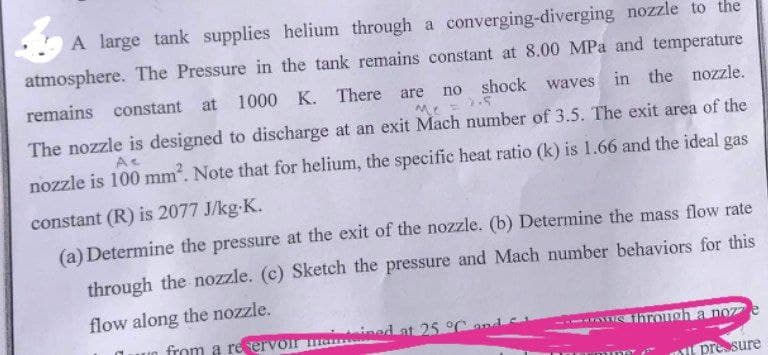A large tank supplies helium through a converging-diverging nozzle l8 atmosphere. The Pressure in the tank remains constant at 8.00 MPa and temperature remains constant at 1000 K. There are no shock waves in the nozzle. The nozzle is designed to discharge at an exit Mach number of 3.5. The exit area of the Ac nozzle is 100 mm. Note that for helium, the specific heat ratio (k) is 1.66 and the ideal gas constant (R) is 2077 J/kg-K. (a) Determine the pressure at the exit of the nozzle. (b) Determine the mass flow rate through the nozzle. (c) Sketch the pressure and Mach number behaviors for this flow along the nozzle. ined at 25 °Cand hrough a noZ7
A large tank supplies helium through a converging-diverging nozzle l8 atmosphere. The Pressure in the tank remains constant at 8.00 MPa and temperature remains constant at 1000 K. There are no shock waves in the nozzle. The nozzle is designed to discharge at an exit Mach number of 3.5. The exit area of the Ac nozzle is 100 mm. Note that for helium, the specific heat ratio (k) is 1.66 and the ideal gas constant (R) is 2077 J/kg-K. (a) Determine the pressure at the exit of the nozzle. (b) Determine the mass flow rate through the nozzle. (c) Sketch the pressure and Mach number behaviors for this flow along the nozzle. ined at 25 °Cand hrough a noZ7
Elements Of Electromagnetics
7th Edition
ISBN:9780190698614
Author:Sadiku, Matthew N. O.
Publisher:Sadiku, Matthew N. O.
ChapterMA: Math Assessment
Section: Chapter Questions
Problem 1.1MA
Related questions
Question
I need the answer as soon as possible

Transcribed Image Text:A large tank supplies helium through a converging-diverging nozzle to the
atmosphere. The Pressure in the tank remains constant at 8.00 MPa and temperature
remains constant at 1000 K. There
are
shock waves in the nozzle.
no
The nozzle is designed to discharge at an exit Mach number of 3.5. The exit area of the
nozzle is 100 mm. Note that for helium, the specific heat ratio (k) is 1.66 and the ideal gas
constant (R) is 2077 J/kg-K.
(a) Determine the pressure at the exit of the nozzle. (b) Determine the mass flow rate
through the nozzle. (c) Sketch the pressure and Mach number behaviors for this
flow along the nozzle.
n from a re ervo ma
ainteined at 25 °Cand
ihrongh a noz
pressure
Expert Solution
This question has been solved!
Explore an expertly crafted, step-by-step solution for a thorough understanding of key concepts.
Step by step
Solved in 3 steps with 2 images

Knowledge Booster
Learn more about
Need a deep-dive on the concept behind this application? Look no further. Learn more about this topic, mechanical-engineering and related others by exploring similar questions and additional content below.Recommended textbooks for you

Elements Of Electromagnetics
Mechanical Engineering
ISBN:
9780190698614
Author:
Sadiku, Matthew N. O.
Publisher:
Oxford University Press

Mechanics of Materials (10th Edition)
Mechanical Engineering
ISBN:
9780134319650
Author:
Russell C. Hibbeler
Publisher:
PEARSON

Thermodynamics: An Engineering Approach
Mechanical Engineering
ISBN:
9781259822674
Author:
Yunus A. Cengel Dr., Michael A. Boles
Publisher:
McGraw-Hill Education

Elements Of Electromagnetics
Mechanical Engineering
ISBN:
9780190698614
Author:
Sadiku, Matthew N. O.
Publisher:
Oxford University Press

Mechanics of Materials (10th Edition)
Mechanical Engineering
ISBN:
9780134319650
Author:
Russell C. Hibbeler
Publisher:
PEARSON

Thermodynamics: An Engineering Approach
Mechanical Engineering
ISBN:
9781259822674
Author:
Yunus A. Cengel Dr., Michael A. Boles
Publisher:
McGraw-Hill Education

Control Systems Engineering
Mechanical Engineering
ISBN:
9781118170519
Author:
Norman S. Nise
Publisher:
WILEY

Mechanics of Materials (MindTap Course List)
Mechanical Engineering
ISBN:
9781337093347
Author:
Barry J. Goodno, James M. Gere
Publisher:
Cengage Learning

Engineering Mechanics: Statics
Mechanical Engineering
ISBN:
9781118807330
Author:
James L. Meriam, L. G. Kraige, J. N. Bolton
Publisher:
WILEY